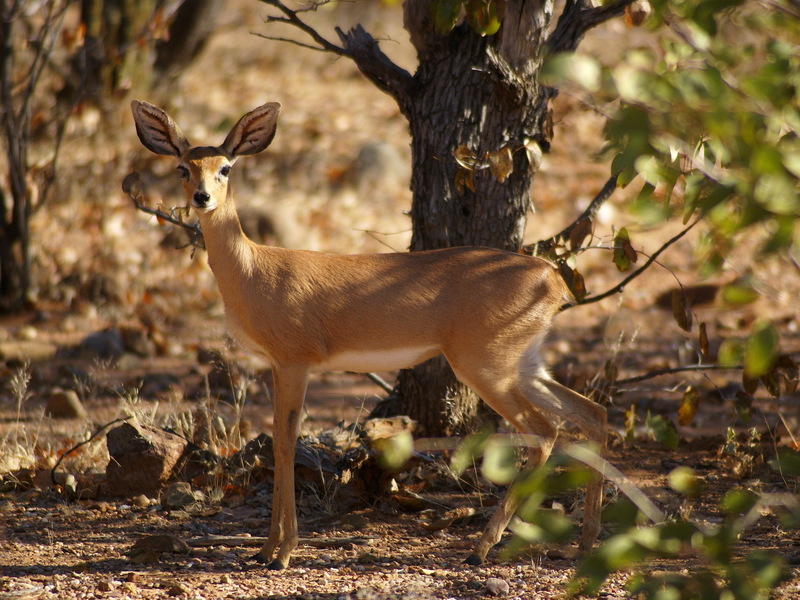|
| 질의: description | 결과: 9567번째/10150 | |
Steenbok (Raphicerus campestris) - Wiki
| 제목: | Steenbok (Raphicerus campestris) - Wiki
| |

| 해상도: 3200x2400
파일크기: 2967976 Bytes
촬영일: 2007:06:26 09:56:09
사진기: DSLR-A100 (SONY )
F number: f/6.3
Exposure: 1/640 sec
Focal Length: 3000/10
등록시간: 2007:11:29 12:03:14
|
Steenbok
From Wikipedia, the free encyclopedia
Order: Artiodactyla
Family: Bovidae
[Photo] Female Steenbok, Raphicerus campestris near Okongwati, Namibia. Date 26/06/2007. Author Hans Hillewaert (http://commons.wikimedia.org/wiki/User:Lycaon).
The Steenbok (Raphicerus campestris) is a common small antelope of southern and eastern Africa. It is also known as the "Steinbuck" or "Steinbok"; not to be confused with the Dutch-language "steenbok" which is an ibex.
Description
Steenbok resemble small Oribi, standing 45???60 cm at the shoulder. Their pelage (coat) is any shade from fawn to rufous, typically rather orange. The underside, including chin and throat, is white, as is the ring around the eye. Ears are large with "finger-marks" on the inside. Males carry straight, smooth, parallel horns 7???19 cm long (see image left). There is a black crescent-shape between the ears, a long black bridge to the glossy black nose, and a black circular scent-gland in front of the eye. The tail is usually invisible, being only 4???6 cm long.
Distribution and Habitat
There are two distinct clusters in Steenbok distribution. In East Africa, it occurs in southern Kenya, Uganda and Tanzania. It was formerly widespread in Uganda, but is now possibly extinct there. In southern Africa, it occurs in Angola, Namibia, South Africa, Swaziland, Botswana, Mozambique, Zambia, Zimbabwe and probably Lesotho.
Steenbok can use a variety of habitats from semi-desert, such as the edge of the Kalahari Desert and Etosha National Park, to open woodland and thickets, including open plains, stony savannah, and Acacia???grassland mosaics. They are said to favour unstable or transitional habitats.
Diet
Steenbok typically browse on low-level vegetation, but are also adept at scraping up roots and tubers. They will also take fruits and seasonally graze on grass. They are almost entirely independent of drinking water, gaining the moisture they need from their food.
Behaviour
During cool periods, Steenbok are active throughout the day; however, during hotter periods, they rest under shade during the heat of the day. While resting, they may be busy grooming, ruminating or taking brief spells of sleep.
Anti-predator
At the first sign of trouble, Steenbok typically lie low in the vegetation. If a predator or perceived threat comes closer, a Steenbok will leap away and follow a zigzag route to try to shake off the pursuer. Escaping Steenbok frequently stop to look back, and flight is alternated with prostration during extended pursuit. They are known to take refuge in the burrows of Aardvarks. Known predators include African Wild Cat, Caracal, Jackals, Leopard, Martial Eagle and Pythons.
Breeding
Steenbok are typically solitary, except for when a pair come together to mate. However, it has been suggested that pairs occupy consistent territories while living independently, staying in contact through scent markings, so that they know where their mate is most of the time. Scent marking is primarily through dung middens. Territories range from 4 hectares to one square kilometre. The male is aggressive during the female's oestrus, engaging in "bluff-and-bluster" type displays with rival males???prolonged contests invariably involve well-matched individuals, usually in their prime.
Breeding occurs throughout the year, although more fawns are born November to December in the southern spring???summer; some females may breed twice a year. Gestation period is about 170 days, and almost always there is a single precocious fawn. The fawn is kept hidden in vegetation for 2 weeks, but they suckle for 3 months. Females become sexually mature at 6???8 months and males at 9 months.
Steenbok are known to live for 7 years or more.
Taxonomy
Two subspecies are recognized: R. c. campestris in Southern Africa and R. c. naumanni of East Africa. Up to 24 subspecies have been described from Southern Africa, distinguished on such features as coat colour.
http://en.wikipedia.org/wiki/Steenbok
| The text in this page is based on the copyrighted Wikipedia article shown in above URL. It is used under the GNU Free Documentation License. You may redistribute it, verbatim or modified, providing that you comply with the terms of the GFDL. |
|
^o^
동물그림창고 똑똑전화 누리집
^o^
|
|

